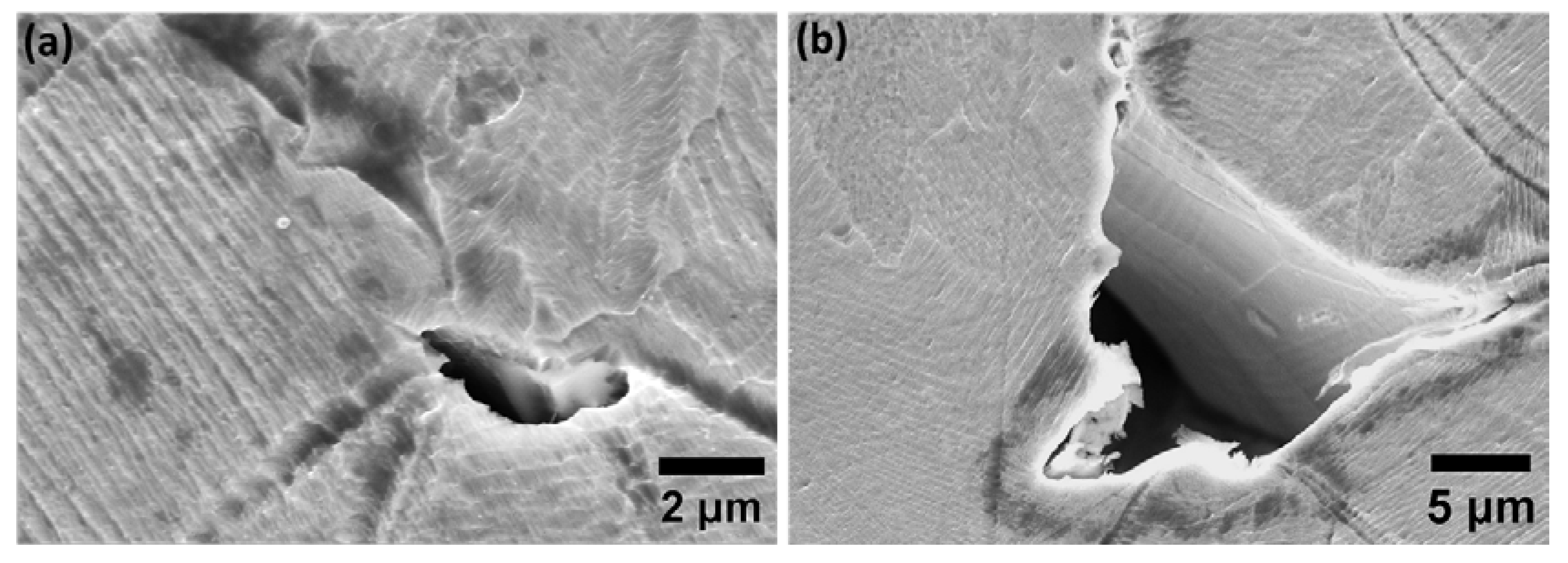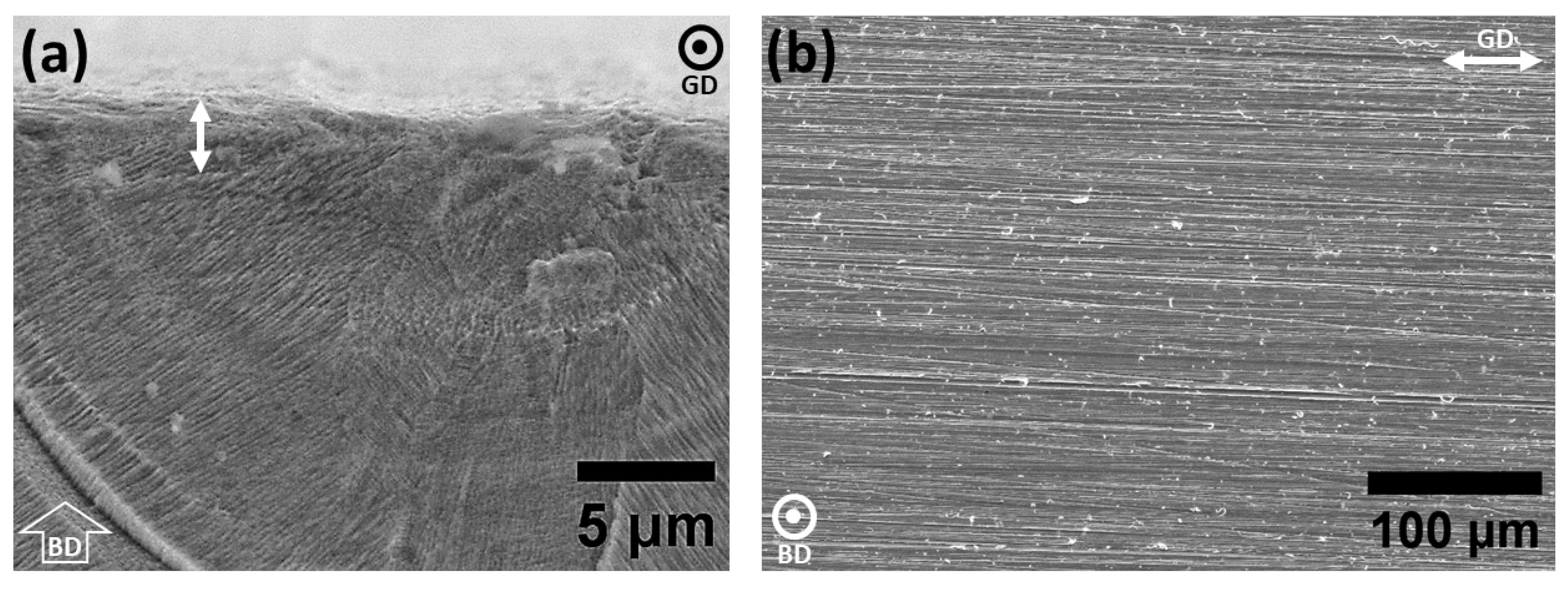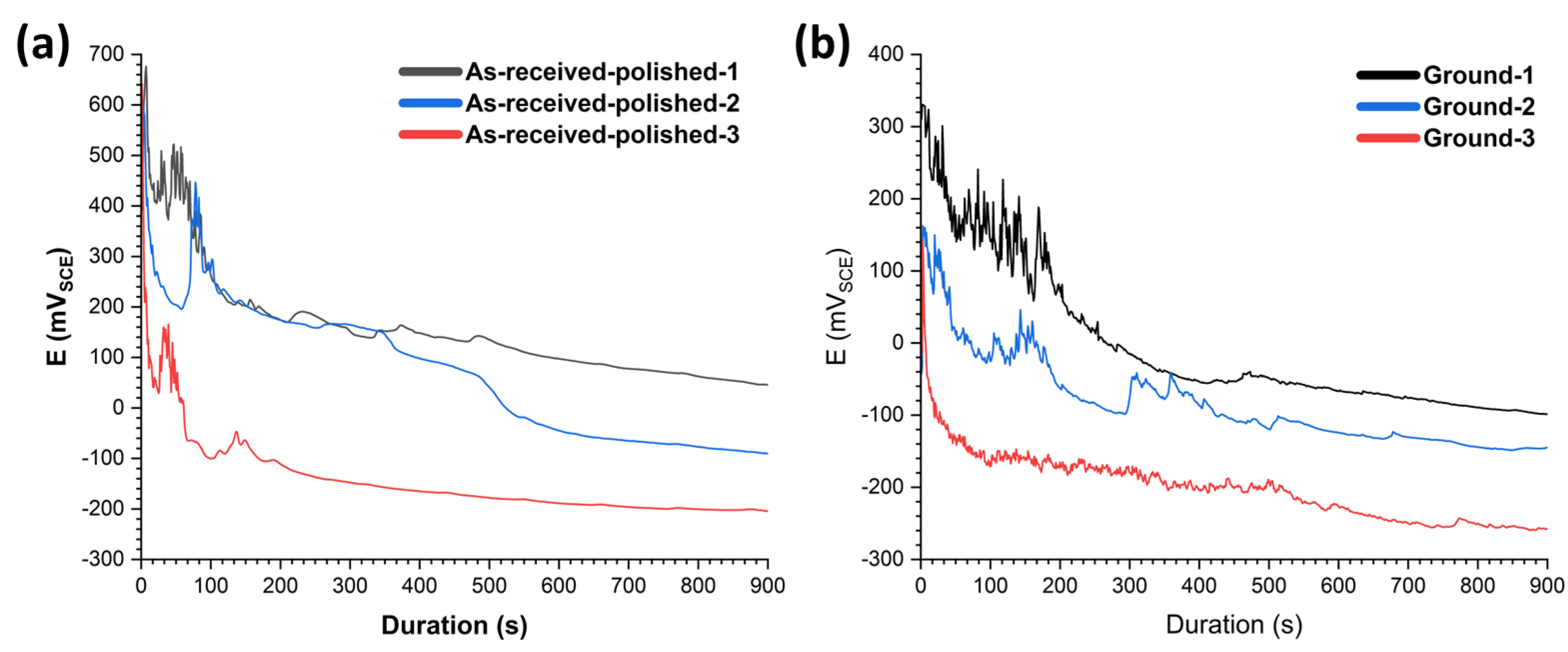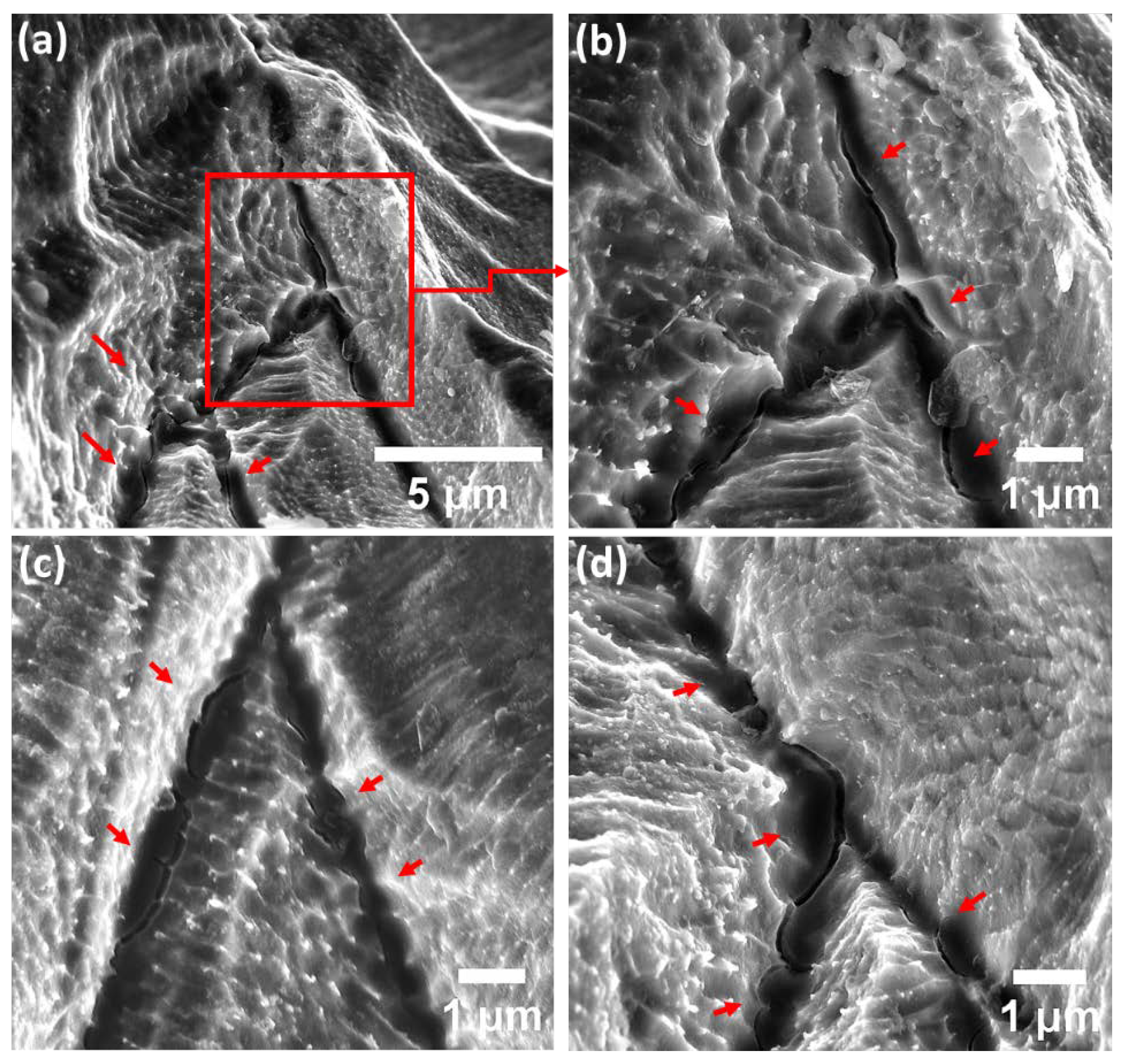Correlation of Lack of Fusion Pores with Stress Corrosion Cracking Susceptibility of L-PBF 316L: Effect of Surface Residual Stresses
Abstract
:1. Introduction
2. Materials and Methods
2.1. L-PBF Fabrication and Sample Preparation
2.2. Residual Stress Measurement
2.3. Electrochemical Polarization and SCC Experiments
2.4. Microstructural and SCC Characterization
3. Results
3.1. Porosity and Microstructural Characterization
3.2. Residual Stress Analysis
3.3. Electrochemical Polarization Results
3.4. Microstructural Analysis of SCC and Localized Corrosion Defects
4. Discussion
4.1. Microstructural Characteristics of L-PBF
4.2. Influence of Defect Type on Electrochemical Polarization Response
4.3. Influence of Pores Size and Type on SCC Initiation under the Effect of Surface RS
5. Conclusions
- A strong correlation was identified between the electrochemical polarization response and defect type and size. For the case of a lack of fusion pores, the range of passivation was much narrower compared to the case of gas porosities.
- Machining-induced surface residual stresses directly affect the SCC initiation susceptibility and electrochemical polarization response of the samples, regardless of defect type.
- For the case of specimens with gas pores, with an increase in pore size, the material resistance to localized corrosion attack was slightly lower, highlighting the effect of pore size on corrosion behaviour.
- Ground specimens with the presence of a lack of fusion pores indicated severe localized corrosion attack at pore sites combined with the SCC at laser track boundaries near the surface.
- The morphology of cracks was different between specimens with gas porosities and lack of fusion pores, highlighting mostly brittle fracture at laser track boundaries for the specimens with lack of fusion pores and corrosion-assisted dissolution of subgrain matrix and fracture of the intact subgrain boundaries for the specimens with gas porosities.
Author Contributions
Funding
Data Availability Statement
Acknowledgments
Conflicts of Interest
References
- Frazier, W.E. Metal Additive Manufacturing: A Review. J. Mater. Eng. Perform. 2014, 23, 1917–1928. [Google Scholar] [CrossRef]
- Khairallah, S.A.; Anderson, A.T.; Rubenchik, A.; King, W.E. Laser Powder-Bed Fusion Additive Manufacturing: Physics of Complex Melt Flow and Formation Mechanisms of Pores, Spatter, and Denudation Zones. Acta Mater. 2016, 108, 36–45. [Google Scholar] [CrossRef] [Green Version]
- Revilla, R.I.; Calster, M.V.; Raes, M.; Arroud, G.; Andreatta, F.; Pyl, L.; Guillaume, P.; Graeve, I.D. Microstructure and Corrosion Behavior of 316L Stainless Steel Prepared Using Different Additive Manufacturing Methods: A Comparative Study Bringing Insights into the Impact of Microstructure on Their Passivity. Corros. Sci. 2020, 176, 108914. [Google Scholar] [CrossRef]
- Strondl, A.; Lyckfeldt, O.; Brodin, H.; Ackelid, U. Characterization and Control of Powder Properties for Additive Manufacturing. JOM 2015, 67, 549–554. [Google Scholar] [CrossRef]
- Ryan, M.P.; Williams, D.E.; Chater, R.J.; Hutton, B.M.; McPhail, D.S. Why Stainless Steel Corrodes. Nature 2002, 415, 770–774. [Google Scholar] [CrossRef]
- Frankel, G.S. Pitting Corrosion of Metals: A Review of the Critical Factors. J. Electrochem. Soc. 1998, 145, 2186. [Google Scholar] [CrossRef]
- Melia, M.A.; Nguyen, H.-D.A.; Rodelas, J.M.; Schindelholz, E.J. Corrosion Properties of 304L Stainless Steel Made by Directed Energy Deposition Additive Manufacturing. Corros. Sci. 2019, 152, 20–30. [Google Scholar] [CrossRef]
- DebRoy, T.; Wei, H.L.; Zuback, J.S.; Mukherjee, T.; Elmer, J.W.; Milewski, J.O.; Beese, A.M.; Wilson-Heid, A.; De, A.; Zhang, W. Additive Manufacturing of Metallic Components—Process, Structure and Properties. Prog. Mater. Sci. 2018, 92, 112–224. [Google Scholar] [CrossRef]
- Vukkum, V.B.; Gupta, R.K. Review on Corrosion Performance of Laser Powder-Bed Fusion Printed 316L Stainless Steel: Effect of Processing Parameters, Manufacturing Defects, Post-Processing, Feedstock, and Microstructure. Mater. Des. 2022, 221, 110874. [Google Scholar] [CrossRef]
- Schaller, R.F.; Mishra, A.; Rodelas, J.M.; Taylor, J.M.; Schindelholz, E.J. The Role of Microstructure and Surface Finish on the Corrosion of Selective Laser Melted 304L. J. Electrochem. Soc. 2018, 165, C234. [Google Scholar] [CrossRef]
- Sander, G.; Thomas, S.; Cruz, V.; Jurg, M.; Birbilis, N.; Gao, X.; Brameld, M.; Hutchinson, C.R. On the Corrosion and Metastable Pitting Characteristics of 316L Stainless Steel Produced by Selective Laser Melting. J. Electrochem. Soc. 2017, 164, C250. [Google Scholar] [CrossRef]
- Laleh, M.; Hughes, A.E.; Yang, S.; Li, J.; Xu, W.; Gibson, I.; Tan, M.Y. Two and Three-Dimensional Characterisation of Localised Corrosion Affected by Lack-of-Fusion Pores in 316L Stainless Steel Produced by Selective Laser Melting. Corros. Sci. 2020, 165, 108394. [Google Scholar] [CrossRef]
- Zhang, Z.; Yuan, X.; Zhao, Z.; Li, X.; Liu, B.; Bai, P. Electrochemical Noise Comparative Study of Pitting Corrosion of 316L Stainless Steel Fabricated by Selective Laser Melting and Wrought. J. Electroanal. Chem. 2021, 894, 115351. [Google Scholar] [CrossRef]
- Krakhmalev, P.; Fredriksson, G.; Svensson, K.; Yadroitsev, I.; Yadroitsava, I.; Thuvander, M.; Peng, R. Microstructure, Solidification Texture, and Thermal Stability of 316 L Stainless Steel Manufactured by Laser Powder Bed Fusion. Metals 2018, 8, 643. [Google Scholar] [CrossRef] [Green Version]
- Yazdanpanah, A.; Pezzato, L.; Dabalà, M. Stress Corrosion Cracking of AISI 304 under Chromium Variation within the Standard Limits: Failure Analysis Implementing Microcapillary Method. Eng. Fail. Anal. 2022, 142, 106797. [Google Scholar] [CrossRef]
- Zhang, W.; Fang, K.; Hu, Y.; Wang, S.; Wang, X. Effect of Machining-Induced Surface Residual Stress on Initiation of Stress Corrosion Cracking in 316 Austenitic Stainless Steel. Corros. Sci. 2016, 108, 173–184. [Google Scholar] [CrossRef]
- Turnbull, A.; Mingard, K.; Lord, J.D.; Roebuck, B.; Tice, D.R.; Mottershead, K.J.; Fairweather, N.D.; Bradbury, A.K. Sensitivity of Stress Corrosion Cracking of Stainless Steel to Surface Machining and Grinding Procedure. Corros. Sci. 2011, 53, 3398–3415. [Google Scholar] [CrossRef]
- Chang, L.; Volpe, L.; Wang, Y.L.; Burke, M.G.; Maurotto, A.; Tice, D.; Lozano-Perez, S.; Scenini, F. Effect of Machining on Stress Corrosion Crack Initiation in Warm-Forged Type 304L Stainless Steel in High Temperature Water. Acta Mater. 2019, 165, 203–214. [Google Scholar] [CrossRef]
- Chang, L.; Burke, M.G.; Scenini, F. Understanding the Effect of Surface Finish on Stress Corrosion Crack Initiation in Warm-Forged Stainless Steel 304L in High-Temperature Water. Scr. Mater. 2019, 164, 1–5. [Google Scholar] [CrossRef]
- Rajaguru, J.; Arunachalam, N. Investigation on Machining Induced Surface and Subsurface Modifications on the Stress Corrosion Crack Growth Behaviour of Super Duplex Stainless Steel. Corros. Sci. 2018, 141, 230–242. [Google Scholar] [CrossRef]
- Turnbull, A. Corrosion Pitting and Environmentally Assisted Small Crack Growth. Proceed. R. Soc. A Math. Phys. Eng. Sci. 2014, 470, 20140254. [Google Scholar] [CrossRef] [PubMed] [Green Version]
- Yazdanpanah, A.; Biglari, F.R.; Arezoodar, A.F.; Dabalà, M. Role of Grinding Induced Surface Residual Stress on Probability of Stress Corrosion Cracks Initiation in 316L Austenitic Stainless Steel in 3.5% Sodium Chloride Aqueous Solution. Corros. Eng. Sci. Technol. 2021, 56, 81–92. [Google Scholar] [CrossRef]
- Yazdanpanah, A.; Franceschi, M.; Bergamo, G.; Bonesso, M.; Dabalà, M. On the Exceptional Stress Corrosion Cracking Susceptibility of Selective Laser Melted 316L Stainless Steel under the Individual Effect of Surface Residual Stresses. Eng. Fail. Anal. 2022, 136, 106192. [Google Scholar] [CrossRef]
- Yazdanpanah, A.; Lago, M.; Gennari, C.; Dabalà, M. Stress Corrosion Cracking Probability of Selective Laser Melted 316l Austenitic Stainless Steel under the Effect of Grinding Induced Residual Stresses. Metals 2021, 11, 327. [Google Scholar] [CrossRef]
- Lou, X.; Song, M.; Emigh, P.W.; Othon, M.A.; Andresen, P.L. On the Stress Corrosion Crack Growth Behaviour in High Temperature Water of 316L Stainless Steel Made by Laser Powder Bed Fusion Additive Manufacturing. Corros. Sci. 2017, 128, 140–153. [Google Scholar] [CrossRef]
- Cruz, V.; Qiu, Y.; Birbilis, N.; Thomas, S. Stress Corrosion Cracking of 316L Manufactured by Laser Powder Bed Fusion in 6% Ferric Chloride Solution. Corros. Sci. 2022, 207, 110535. [Google Scholar] [CrossRef]
- Sutton, A.T.; Kriewall, C.S.; Leu, M.C.; Newkirk, J.W. Powder Characterisation Techniques and Effects of Powder Characteristics on Part Properties in Powder-Bed Fusion Processes. Virtual Phys. Prototyp. 2017, 12, 3–29. [Google Scholar] [CrossRef]
- Li, R.; Shi, Y.; Wang, Z.; Wang, L.; Liu, J.; Jiang, W. Densification Behavior of Gas and Water Atomized 316L Stainless Steel Powder during Selective Laser Melting. Appl. Surf. Sci. 2010, 256, 4350–4356. [Google Scholar] [CrossRef]
- Eliasu, A.; Czekanski, A.; Boakye-Yiadom, S. Effect of Laser Powder Bed Fusion Parameters on the Microstructural Evolution and Hardness of 316L Stainless Steel. Int. J. Adv. Manuf. Technol. 2021, 113, 2651–2669. [Google Scholar] [CrossRef]
- Cherry, J.A.; Davies, H.M.; Mehmood, S.; Lavery, N.P.; Brown, S.G.R.; Sienz, J. Investigation into the Effect of Process Parameters on Microstructural and Physical Properties of 316L Stainless Steel Parts by Selective Laser Melting. Int. J. Adv. Manuf. Technol. 2015, 76, 869–879. [Google Scholar] [CrossRef]
- Sander, G.; Cruz, V.; Bhat, N.; Birbilis, N. On the In-Situ Characterisation of Metastable Pitting Using 316L Stainless Steel as a Case Study. Corros. Sci. 2020, 177, 109004. [Google Scholar] [CrossRef]
- Wang, G.; Liu, Q.; Rao, H.; Liu, H.; Qiu, C. Influence of Porosity and Microstructure on Mechanical and Corrosion Properties of a Selectively Laser Melted Stainless Steel. J. Alloys Compd. 2020, 831, 154815. [Google Scholar] [CrossRef]
- Kong, D.; Dong, C.; Wei, S.; Ni, X.; Zhang, L.; Li, R.; Wang, L.; Man, C.; Li, X. About Metastable Cellular Structure in Additively Manufactured Austenitic Stainless Steels. Addit. Manuf. 2021, 38, 101804. [Google Scholar] [CrossRef]
- Prashanth, K.G.; Eckert, J. Formation of Metastable Cellular Microstructures in Selective Laser Melted Alloys. J. Alloys Compd. 2017, 707, 27–34. [Google Scholar] [CrossRef]
- Baker, M.A.; Castle, J.E. The Initiation of Pitting Corrosion at MnS Inclusions. Corros. Sci. 1993, 34, 667–682. [Google Scholar] [CrossRef]
- Man, C.; Dong, C.; Liu, T.; Kong, D.; Wang, D.; Li, X. The Enhancement of Microstructure on the Passive and Pitting Behaviors of Selective Laser Melting 316L SS in Simulated Body Fluid. Appl. Surf. Sci. 2019, 467, 193–205. [Google Scholar] [CrossRef]
- Stratmann, M.; Rohwerder, M. A Pore View of Corrosion. Nature 2001, 410, 421–423. [Google Scholar] [CrossRef]
- Chao, Q.; Cruz, V.; Thomas, S.; Birbilis, N.; Collins, P.; Taylor, A.; Hodgson, P.D.; Fabijanic, D. On the Enhanced Corrosion Resistance of a Selective Laser Melted Austenitic Stainless Steel. Scr. Mater. 2017, 141, 94–98. [Google Scholar] [CrossRef]
- Evans, U.R. The Electrochemical Character of Corrosion. J. Inst. Metals 1923, 30, 239–282. [Google Scholar]
- Engelhardt, G.R.; Macdonald, D.D.; Urquidi-Macdonald, M. Development of Fast Algorithms for Estimating Stress Corrosion Crack Growth Rate. Corros. Sci. 1999, 41, 2267–2302. [Google Scholar] [CrossRef]
- Engelhardt, G.; Urquidi-Macdonald, M.; Macdonald, D.D. A Simplified Method for Estimating Corrosion Cavity Growth Rates. Corros. Sci. 1997, 39, 419–441. [Google Scholar] [CrossRef]
- MacDonald, D.D.; Urquidi-MacDonald, M. A Coupled Environment Model for Stress Corrosion Cracking in Sensitized Type 304 Stainless Steel in LWR Environments. Corros. Sci. 1991, 32, 51–81. [Google Scholar] [CrossRef]
- Zhou, X.; Balachov, I.; Macdonald, D.D. The Effect of Dielectric Coatings on IGSCC in Sensitized Type 304 SS in High Temperature Dilute Sodium Sulfate Solution. Corros. Sci. 1998, 40, 1349–1362. [Google Scholar] [CrossRef]
- Vankeerberghen, M.; Macdonald, D.D. Predicting Crack Growth Rate vs. Temperature Behaviour of Type 304 Stainless Steel in Dilute Sulphuric Acid Solutions. Corros. Sci. 2002, 44, 1425–1441. [Google Scholar] [CrossRef]
- Yazdanpanah, A.; Franceschi, M.; Revilla, R.I.; Khademzadeh, S.; Graeve, I.D.; Dabalà, M. Revealing the Stress Corrosion Cracking Initiation Mechanism of Alloy 718 Prepared by Laser Powder Bed Fusion Assessed by Microcapillary Method. Corros. Sci. 2022, 208, 110642. [Google Scholar] [CrossRef]
- Sander, G.; Babu, A.P.; Gao, X.; Jiang, D.; Birbilis, N. On the Effect of Build Orientation and Residual Stress on the Corrosion of 316L Stainless Steel Prepared by Selective Laser Melting. Corros. Sci. 2021, 179, 109149. [Google Scholar] [CrossRef]
- Choudhary, S.; Birbilis, N.; Thomas, S. Evolution of Passivity for the Multi-Principal Element Alloy CoCrFeNi with Potential, PH, and Exposure in Chloride Solution. Corrosion 2022, 78, 49–57. [Google Scholar] [CrossRef]
- Choudhary, S.; Cruz, V.; Pandey, A.; Thomas, S.; Birbilis, N. Element-Resolved Electrochemical Analysis of the Passivity of Additively Manufactured Stainless Steel 316L. Corros. Sci. 2021, 189, 109576. [Google Scholar] [CrossRef]
- Macdonald, D.D. The History of the Point Defect Model for the Passive State: A Brief Review of Film Growth Aspects. Electrochim. Acta 2011, 56, 1761–1772. [Google Scholar] [CrossRef]
- Macdonald, D.D. The Point Defect Model for the Passive State. J. Electrochem. Soc. 1992, 139, 3434. [Google Scholar] [CrossRef]
- Laleh, M.; Hughes, A.E.; Yang, S.; Wang, J.; Li, J.; Glenn, A.M.; Xu, W.; Tan, M.Y. A Critical Insight into Lack-of-Fusion Pore Structures in Additively Manufactured Stainless Steel. Addit. Manuf. 2021, 38, 101762. [Google Scholar] [CrossRef]









| Sample Group No. | Laser Power (W) | Scan Speed (mm·s−1) | Energy Input (J·mm−3) |
|---|---|---|---|
| 1 | 120 | 800 | 107 |
| 2 | 135 | 800 | 121 |
| 3 | 90 | 1200 | 54 |
| Sample Group | Density Mean (%) | Pore Surface Area Mean (µm2) | Max. Pore Surface Area (µm2) | Porosity Std Dev. (%) | Porosity Mean (%) |
|---|---|---|---|---|---|
| 1 | 99.91 | 4.53 | 390.62 | 0.05 | 0.09 |
| 2 | 99.74 | 15.89 | 612.21 | 0.09 | 0.26 |
| 3 | 97.2 | 175.05 | 1843.83 | 0.5 | 2.8 |
| Group No. | As-Received Polished | Ground | ||
|---|---|---|---|---|
| Longitudinal (MPa) | Transverse (MPa) | Longitudinal (MPa) | Transverse (Mpa) | |
| 1 | −258 ± 6 | −210 ± 8 | 308 ± 12 | 173 ± 9 |
| 2 | −241 ± 9 | −187 ± 12 | 332 ± 8 | 196 ± 9 |
| 3 | −193 ± 9 | −149 ± 6 | 314 ± 13 | 184 ± 12 |
Publisher’s Note: MDPI stays neutral with regard to jurisdictional claims in published maps and institutional affiliations. |
© 2022 by the authors. Licensee MDPI, Basel, Switzerland. This article is an open access article distributed under the terms and conditions of the Creative Commons Attribution (CC BY) license (https://creativecommons.org/licenses/by/4.0/).
Share and Cite
Yazdanpanah, A.; Franceschi, M.; Rebesan, P.; Dabalà, M. Correlation of Lack of Fusion Pores with Stress Corrosion Cracking Susceptibility of L-PBF 316L: Effect of Surface Residual Stresses. Materials 2022, 15, 7151. https://doi.org/10.3390/ma15207151
Yazdanpanah A, Franceschi M, Rebesan P, Dabalà M. Correlation of Lack of Fusion Pores with Stress Corrosion Cracking Susceptibility of L-PBF 316L: Effect of Surface Residual Stresses. Materials. 2022; 15(20):7151. https://doi.org/10.3390/ma15207151
Chicago/Turabian StyleYazdanpanah, Arshad, Mattia Franceschi, Pietro Rebesan, and Manuele Dabalà. 2022. "Correlation of Lack of Fusion Pores with Stress Corrosion Cracking Susceptibility of L-PBF 316L: Effect of Surface Residual Stresses" Materials 15, no. 20: 7151. https://doi.org/10.3390/ma15207151







